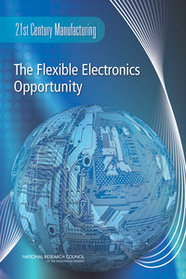
- The United States should increase funding of basic research related to flexible electronics and augment support for university-based consortia to develop prototypes, manufacturing processes, and products in close collaboration with contributing industrial partners.
- Consortia, bringing together industry, universities, and various levels of government, should be used as a means of fostering precompetitive applied research in flexible electronics.
- The United States should establish and support a network of user facilities dedicated to flexible electronics.
- Where possible, federal efforts to support the growth of competitive flexible electronics industries should leverage state and regional developmental efforts, with the objective of establishing co-located local supply chains and capturing the associated cluster synergies.
- Agency mission needs should help drive demand for flexible electronics technologies, while lowering costs, improving capabilities, and contributing to the development of a skilled workforce.
These recommendations build upon the developments by numerous institutions in establishing industry consortia user facilities to transition the innovations in materials, processes, and integration to industrially meaningful platforms. As such, innovations in nanomaterials and nanomanufacturing processes emerging from NSF Nanoscale Science and Engineering Centers (NSECS) and Nanosystems Engineering Research Centers (NERCs) will play a pivotal role in the innovation cycle to accelerate developments in flexible-hybrid electronics technologies and manufacturing platforms. Complimenting this are the manufacturing demonstration facilities that have been established at various universities as industry user facilities to take advantage of these emerging processes and cutting edge tools that are unavailable elsewhere. Examples include the Center for Advanced Microelectronics Manufacturing (CAMM) at Binghamton University, the Flexible Display Center at Arizona State University, and the Center for Advanced Roll-to-Roll Manufacturing at the University of Massachusetts Amherst. The examples of academic driven public-private partnerships provide leading edge capabilities accessible to industry for acceleration of innovative product development.
